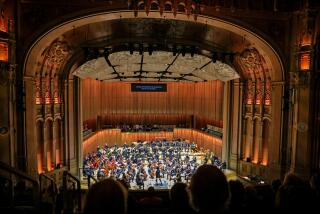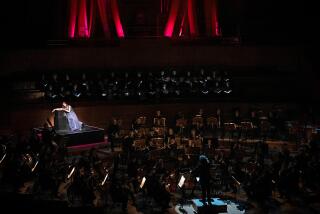MUSIC REVIEW : Stern Fiddles While Cerritos Learns
- Share via
It wasn’t your average evening with a little Brahms, Mozart, Bartok and Beethoven.
“Enjoy the show,” said the first friendly ticket-taker, stationed at the door.
“Enjoy the show,” echoed the second friendly ticket-taker, impeding traffic at the distant entry to the auditorium.
“Enjoy the show,” echoed the friendly usher in the inner sanctum, a room that invokes movie-palace opulence in burnished tones of neo-Deco-busy.
The show on Friday was a sophisticated recital by the veteran virtuoso of the violin, Isaac Stern. The showplace, plush and pretty, was the $60-million Center for the Performing Arts in Cerritos. The event, quietly historic, was the first venture in so-called classical music at this cultural edifice complex, which had been inaugurated by another septuagenarian virtuoso, Frank Sinatra, on Jan. 13.
The most pressing questions in the air did not involve Stern. Everyone knows that his place is secure among the most discerning musicians of the century. Nearly everyone also knows that, at 72, he finds himself at the twilight of a noble career.
No one knew for sure, however, how a lonely fiddle and piano would sound in the flexible, multi-purpose hall. Nor did anyone know if this bedroom community in southeastern Los Angeles County, population 53,800, could sell music as well as it sells cars.
The answer remains a bit inconclusive.
From a centrally located aisle seat downstairs (thank goodness for aisles), Stern’s tone--always more notable for poise than for opulence--sounded a bit wan and wiry, especially at range extremes. It was hard to decide if the problems were related to the performer or the acoustics. The accompanying piano, ably if discreetly manned by Robert McDonald, sounded relatively bright, strong and crisp.
One didn’t sense a lot of presence, or hear a great deal of resonance. But the essential definitions were definitely in order. And, after too many all-American experiences with tiny nuances lost in huge places, one welcomed the aura of intimacy.
The management opted on this occasion for what it labels “concert configuration.” That means the open stage is moved to a conventional theatrical location at the front. A part of the audience is stationed beyond it, however, on risers and in loges, Concertgebouw style.
In a typically gracious gesture at the end of the evening, Stern announced--sonorously, despite the absence of amplification--that he would play an encore to the patrons behind the stage. When he turned his back on the listeners out front, the sound of his violin became, if anything, more immediate.
Larry Kirkegaard, the acoustician from Chicago, admitted during intermission that some fine tuning remained to be accomplished. That, of course, is normal.
According to official statistics, the capacity for “concert configuration” should be 1,963. A spokesman for the center said, however, that the house had been set up to accommodate 1,515. One wondered if Cerritos had reduced the seating in response to disappointment at the box office.
It was clear, in any case, that the conventions of concert presentation are not yet second-nature here. The early ads for Stern listed meaningless generic titles (“Sonata in A Major”) but no composers. The current ads for the St. Louis Symphony--which comes next month and will no doubt tell us more about essential acoustical conditions--mention no conductor (anyone for Leonard Slatkin?).
The house program provided much puffery but no annotations and inadequate credits. The arranger of Bartok’s Romanian Dances remained anonymous.
The audience clapped after every internal movement, even though Stern offered no encouragement, and mustered a standing ovation at the end. Still, there was insufficient applause for more than one encore (Kreisler’s “Liebesleid”). At the Music Center on Wednesday, Stern had played two.
The agenda began with Brahms’ “Sonatensatz,” which seemed a bit nervous, followed by the rhapsodic A-major Sonata, Opus 100. Stern was most persuasive in the dreamy legato of the Andante Tranquillo. The same key remained in force for Mozart’s Sonata, K. 526, in a basically stylish performance occasionally marred by strident pitch.
After intermission, Stern reveled in the theatrics of the Bartok dances as transcribed by Zoltan Szekely. Beethoven’s Sonata No. 7 in C gave the evening its lofty climax, the high point coming in the lyricism of the slow movement.
A beginning. . . .
More to Read
The biggest entertainment stories
Get our big stories about Hollywood, film, television, music, arts, culture and more right in your inbox as soon as they publish.
You may occasionally receive promotional content from the Los Angeles Times.










